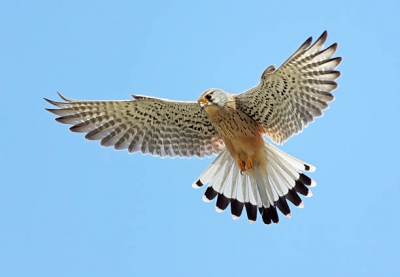
The common kestrel, or Falco tinnunculus, is a small-sized raptor that belongs to the family Falconidae. It is found in Asia, Africa, Europe and North America. It is a light, chestnut-brown bird with blackish spots on the upper side and narrow blackish streaks on the underside.
Like all falcons, this raptor has long wings and a long tail. The head and tail are gray in males, but the tail is brown with black bars in females. Both males and females have a black-tipped tail with a narrow, white rim. The feet are yellow and the eyes are outlined with a narrow yellow ring. The eyes and beak are dark.
It inhabits fields, heaths, shrubland, wetlands, moorlands and marshlands and feeds on small mammals and birds. It also adapts well to human settlements. It usually hunts by hovering about 10 to 20 meters above the ground scanning the undergrowth for voles, shrews and mice, which constitute 3/4th of its diet. Interestingly, this bird is a hunter as well as a detective! It often hunts based on urine traces left behind by potential prey which it is able to see in ultraviolet light. It makes a short, steep dive towards its prey on the ground or ambushes its prey by flying close to the ground over a selected area.
The common kestrel is a cavity nester, which means that it prefers holes in the sides of cliffs, trees and even buildings. They may also reuse the nests of other birds. The female typically lays 3 to 7 brown-spotted eggs and incubates them over a period of 26 to 32 days.
The IUCN has listed these birds under ‘Least Concern’ in the Red List.
Picture Credit : Google




